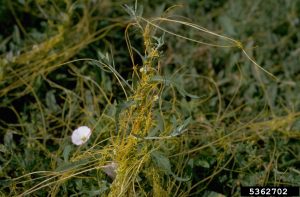Chapter 2: Why Are Weeds So Successful? Basic Ecology Concepts
2.6 Interference
Interference is a term used to explain how weeds can affect our crop plants. There are several ways in which weeds can negatively impact the vigor of field crops, which leads to lower yields and performance. We will review three types of interference here.
- Competition, whether that is competition for light or water or nutrients, weeds can reduce crop yield by outcompeting crops for these resources.
- Allelopathy, is when a weed produces a biological toxin and releases it into the soil. This then prevents other plants from growing near the weed.
- Parasitism is an extreme case where the weeds actually live off of the crop plants.
Competition
At the start of the growing season, whichever plant gets established first, whether it is a weed or the crop, will receive and benefit from most of the nutrients, soil moisture and light. The plant successfully able to outcompete will establish a stronger root and leaf system. In general, broadleaf weeds emerge at the same time as crops and are actually faster at getting established. If left untreated, weeds are typically going to cause crop yield loss because they outcompete crop plants for resources. As a result, we want to control the weeds during the first six to eight weeks of a crop plant’s life cycle. This will give the crop a chance to close the canopy. The crop is then strong enough to outcompete weeds and the closed canopy further shades out weeds. In a later chapter we will introduce the concept of “critical period of weed control” and how this can help you cost effectively manage weeds.
Allelopathy
Another way weeds are able to outcompete crop plants is by releasing into the soil, a toxic chemical that inhibits other plants from being able to grow near it. This is referred to as allelopathy. Here is a list of weeds known to have this unique ability:
- Giant foxtail (Setaria faberi Herrm.)
- Large crabgrass (Digitaria sanguinalis (L.) Scop)
- Johnsongrass (Sorghum halepense (L.) Pers.)
- Yellow nutsedge (Cyperus esculentus L.)
- Canada thistle (Cirsium arvense (L.) Scop.)
- Common sunflower (Helianthus annuus L.)
Parasitism

Parasitism, is the third type of competition we will explore. In this case, what happens is the weed will actually attach to a crop plant and use it as a host. The parasitic weed does not have any mechanism for completing photosynthesis, so it is entirely dependent on the host for nutrients and photosynthetic sugars.
Review and Reflection